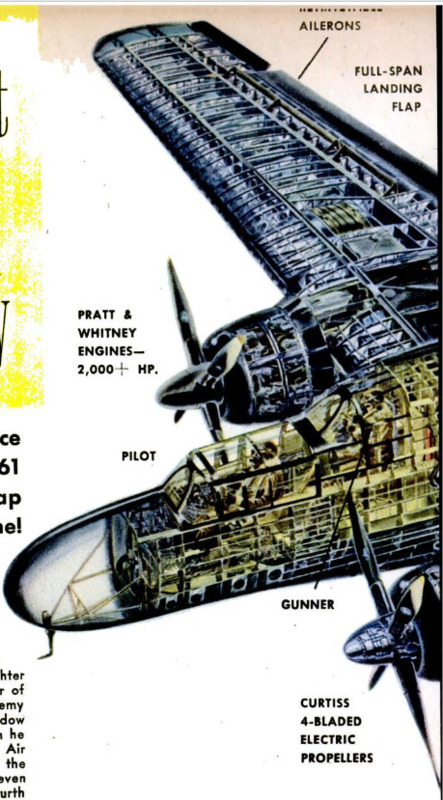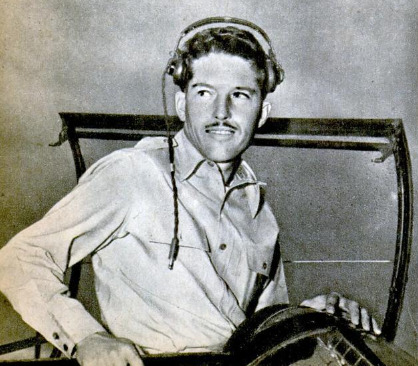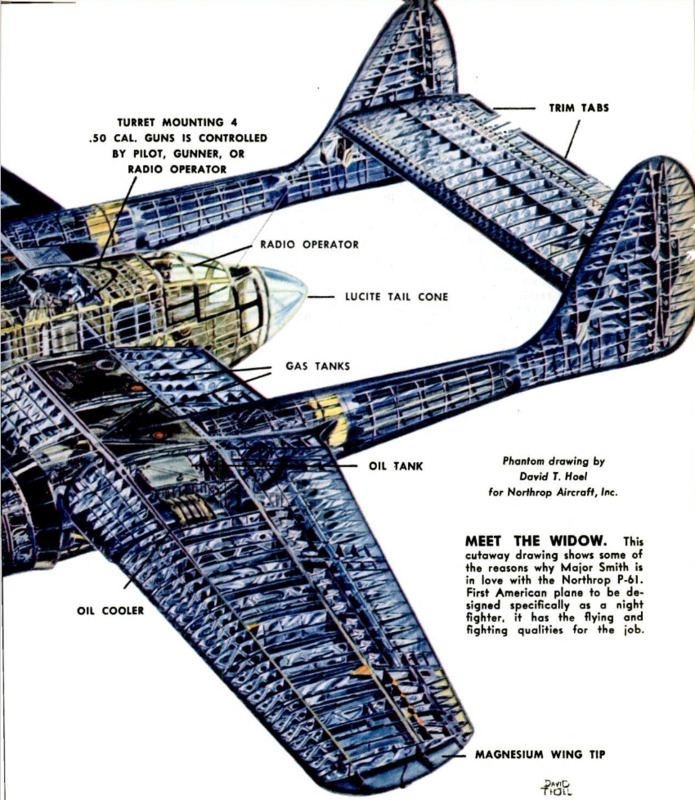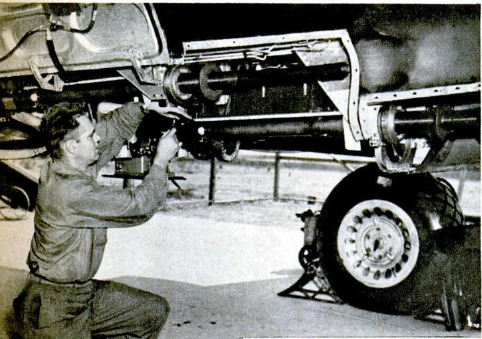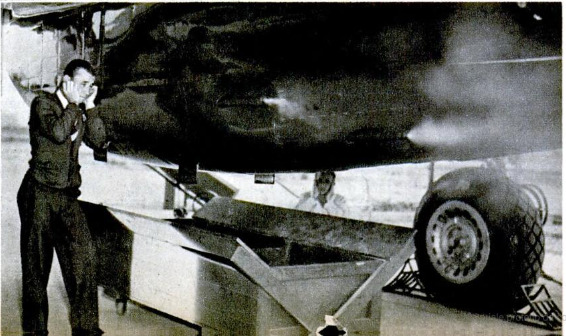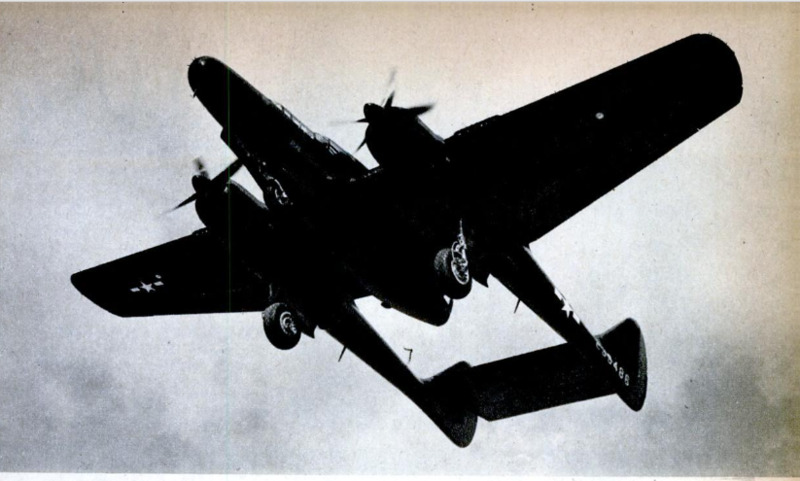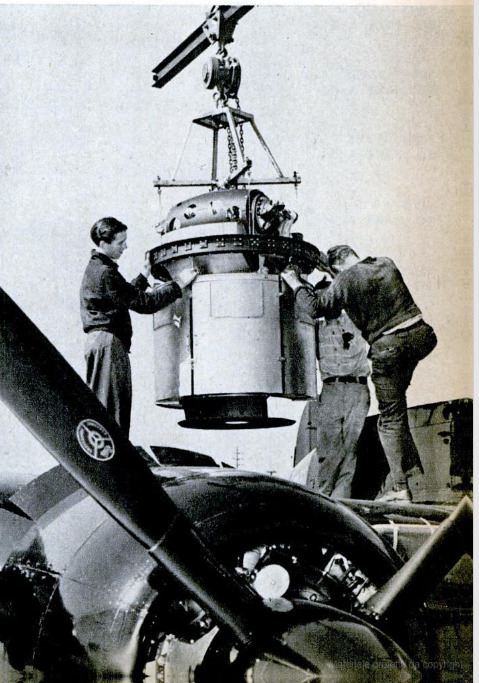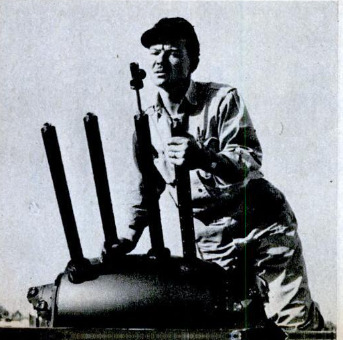-
Title (Dublin Core)
-
My sweetheart is a black widow
-
Article Title and/or Image Caption (Dublin Core)
-
My sweetheart is a black widow
-
extracted text (Extract Text)
-
THAT Jap pilot tooling his twin-engine
Dinah Mark II toward our airstrip at
Morotai wasn't worried. At 8,000 feet his
fighter was invisible (he thought), his
20-mm. cannon and 7.7-mm. machine guns
would protect him in a clinch, and as a last
resort he could climb a mile in 90 seconds
or so to evade us. g
"He hadn't the foggiest notion that Lt.
Phil Porter and I were floating in the
moonlit night over the field, throttled to
minimum cruising. We were saving gas,
to make sure we'd have plenty in case a
Nip came over.
He still wasn't worried when our ground
control picked him up and flashed the first
order: ‘“Darkie One from Nightie. Climb
to 8,000 . . . course two zero zero . . .
range about 12 miles.” Instantly I turned
my attention to my instruments. Phil
shouted instructions as I swung the Black
Widow onto the new heading. I flipped on
the water injection to pull another six
inches of manifold pressure. That meant
200 to 300 more horsepower from the big
Pratt & Whitneys . . . 300 feet a minute
faster climb.
While ground control continued direct-
ing us toward the incoming fighter, I
climbed and turned with everything jammed
to the fire wall. The Jap was headed for
our field, bearing a load of medium bombs.
A few more seconds, and we spotted each
other in the brilliant moonlight, at a range
of 2,000 feet. He then was within a mile
of our base.
Talk about evasive action! That boy
could fly: He was worried now, for the
Nips had heard about these deadly Black
‘Widows. Ours were fairly new, but those
four 20-mm. cannons spouting flame and
shells from the belly spelled certain and
swift destruction to any fighter or bomber
within range.
I could see him easily as he climbed. His
maneuver was no good, for the Widow was
climbing even faster. I began overhauling
him at 17,500. Three bursts failed to hit.
The fourth and fifth seemed to do little
damage. For the sixth I managed to pull
in within 150 feet of his left wing and cut
loose with a full deflection shot as he
roared past. Chunks exploded from the
glistening Dinah. He fell, burning, a plume
of smoke following him to earth.
This was not my first kill. Some time
earlier, while flying a P-38 Lightning over
Jap-held Alexishaven, New Guinea, on dusk
patrol, T had picked off a Val dive bomber
as the plane was about to land. Three
bursts of about 150, 30, and 20 rounds
blasted its crew to their honorable an-
cestors. But now the Black Widows were
beginning to arrive. Here we had the first
American plane specially designed for night
fighting. With it we could do things under
cover of darkness that we dared not at-
tempt with other types.
Three weeks later, while flying a Light-
ning, I snagged on successive nights a
probable, one Betty, and a probable. The
Betty is a twin-engine medium %omber
similar to our Mitchell. Shooting down a
Betty from a P-38 isn't like smashing one
from a Widow in complete darkness.
Searchlights picked her out and held her
for me, and I ran her down after she had
unloaded her bombs on Morotai. She
couldn't climb like the Dinah, so I got her
with two bursts from directly behind as
we screamed down. My air-speed meter
indicated 475; actually it was much more.
Betty began to burn as I shot past, and
cartwheeled into the water offshore.
Shooting down Nips at night gives you a
grim satisfaction unmatched by daytime
victories. Aided by detection
equipment, you can stalk them as
a tiger stalks its prey and blast
them into the beyond, frequently
before they know you're tailing
them.
For the record, the Widows
have “killed” nearly every plane
shot at since they first started
west from the Northrop plant in
California in June 1944. Not one
Widow has been lost, at this writ-
ing, to enemy action in the
Pacific. I know of only one to be
missing on a mission, and 1 have
fairly good reason to think that its
crew ditched near the Philippines,
and that they are safe today.
I was skeptical of the first Black
Widow T saw. “She's awkward as
a hox kite,” I remember thinking.
“She's too big and clumsy to be a
fighter.” But when you make high-
speed stalls into a dead engine, in
the dead
of night; when you can climb away from
the Tonys, Tojos, and Franks and turn with
‘em; when she always brings you home
from dangerous lone-wolf intruder missions;
and when you know her cannons will knock
out of the sky anything that flies and never
jam—brother, you've got an airplane that’s
both safe and deadly. (Not until recent
weeks did Black Widows carrying four .50
caliber machine guns in the top turret
reach our squadron.)
Only in a plane designed and equipped for
the purpose is the specialized and compara-
tively new operation of night fighting cer-
tain of success. The Widow carries in her
two engines more than 4,000 horsepower—
as much as a Diesel locomotive. Full-span
flaps shorten take-off and landing distances,
50 we can operate from short fields, under
fire. Retractable ailerons of the spoiler type
shorten the turning radius and give us easy
control at high speeds. Elevator booster
tabs, unusual on a fighter, make it easier
to actuate controls, especiaily in tight, steep
turns. Usually, we need all their aid when
winging away to protect a convoy or to
stop the Jap before he can blast our own
installations with machine guns and bombs.
No telltale tracers stream out from our
guns. We make ourselves as inconspicuous
as possible. We sneak in, kill, and run. By
sneaking and striking, my squadron of 12
planes bagged 14 Jap planes in 11 nights
over and near Mindoro, in the Philippines.
Four of these, as luck had it, were mine—
all shot down in a single night.
‘We moved from Morotai to Mindoro the
day after Christmas to protect a new air-
strip and cover invasion convoys moving
north to Luzon. Gunfire from a Jap naval
task force drove us away that night. I
hovered over the Jap ships until long after
midnight, keeping up a Clem McCarthy
running account so that the B-25's and
B-24's of the Fifth Air Force, and day
fighters acting as dive bombers, could drop
their loads on the best targets. Gas low, I
pulled out to land at Valencia, near Ormoc,
on Leyte on a grassy strip illuminated
briefly by the lights of jeeps parked along
the edges.
Early in the morning, I flew on to Taclo-
ban, where I found the rest of my squad-
ron's planes and crews safe. After refuel-
ing, we returned to Mindoro to take over
night patrols and night convoy cover. At
dusk and dawn, four-plane flights patrolled
in regular fighter formation off the fringes
of the convoys. Two patrols protected our
base. After darkness fell, single plane flights
covered the convoys. Even in the moon-
light, the hundreds of ships seemed to
stretch beyond the horizons, a mighty por-
tent of trouble brewing for the Japs on
Luzon. We really pushed ‘em those nights.
The squadron's planes averaged 10 hours in
the air. We flew halfway around the world
every night.
With more than 100 night missions be-
hind me, I long ago had overcome my dread
of lack of vision. You don't fly these killers
by the seat of your pants. You trust to
your many instruments. I placed utmost
confidence in both the plane and the instru-
ments. You've got to trust ‘em when the
radio's silent, and you're up there in a void
weaving around the sky three and four
hours. It's a monotonous, lonely job—but
fairly safe if you keep a cool head. The
job, as the British say, calls for “dash with
discretion.”
Theoretically, you never shoot down an
enemy plane by instruments alone. You
need visual contact. On a bright, moonlit
night, T found I could see a Jap plane a
half mile away. When clouds or storm ob-
scured the moon, I've sneaked up within
200 feet of a twin-engine bomber without
being sure whether he was friend or foe.
If he didn’t reply with the proper code to
our signal, it was “Katy bar the gate.”
Something awful would happen.
Business proceeded as usual until the
night of January 7. That's when the can-
nons of my “Time’s-A-Wastin'” got four—
two Irving bombers, a float recon plane,
and a Frank.
Three of us took off shortly before dusk
and flew 50 miles south to cover a convoy
of 300 ships. Thirty minutes after the light
began to fade, I sent my two wing planes
back, and continued my patrol alone. It
was perhaps an hour later when the fighter
director ship messaged: “Indications plane
coming from southwest—8,000 feet—12 to
15 miles away.”
1 set a collision course, climbing and hop-
ing to intercept the Jap at a safe distance
from the convoy. I closed in fast, and first
saw him two miles away, scudding toward
a cloud. Both Phil and I identified him in-
stantly: An Irving, similar to a Nick, only
slightly larger. A deadly 20-mm. stinger in
the tail, and three 12.9-mm. machine guns.
Mustn't let him get in the first burst.
For seven minutes I chased the fellow.
He turned in and out of the clouds. Grad-
ually we descended. I hit him with a short
burst as he entered one patch of cloud, and
got away a second burst, the bullets striking
around the wing roots, when he came out
in a turn, His tail stinger was chattering,
but not for long. Down he dived, burning,
to disappear completely.
The Irving was swallowed by the sea at
nine o'clock, straight up. We circled only
long enough for Phil to confirm the kill T
headed west, climbing to patrol altitude of
8,000 feet, to place myself off the west side
of the convoy once more. Within a couple
of minutes Phil spotted another one. “About
11 o'clock,” he grunted. “Same altitude.” I
swung the plane a needles width or so.
Then I saw him, another Irving, etched
against the moon.
He was so close to the convoy I had no
chance to maneuver for a tail shot. I
opened her up wide, in a head-on approach,
diving to cut off the Irving before he started
his bomb run. At 800 feet I cut loose with
a three-second burst. Slugs bit into the
canopy, others opened his fuel tanks. Sev-
eral pieces flew off. The plane tumbled
1,500 feet and blazed merrily as it glided
into the water.
By now, our gas was dangerously low.
We landed to fuel, grab a cup of coffee,
and snatch forty winks. The ground crew
had no time to rearm the guns, but I figured
we had maybe half the 700 rounds we had
started with. Shortly before three we rolled
off the dark runway to patrol locally. Our
plane took the west sector. For a half hour
we sat there, 20 miles off the island, “orbit-
ing the beacon” in a 25-mile-long shuttle at
“an altitude of expectancy.” This meant
7,000, for the Japs had been coming over
at 8,000 or lower.
Two in one night was a good score, I was
thinking, when ground control broke into
my thoughts: “Smith from Barr. Start
letting down on course of three zero zero.
Level off at three thousand.” Minor changes
came through rapidly: “Take course three
Wo zero . . new course zero six zero.” The
Jap apparently was coming from the north,
offshore. Ground control was bringing me
toward the coastline for an interception.
“Course two seven zero . . . let down to
1500 feet.” Now Phil took over. “Let
down,” he shouted. “Steady . .. right...
steady . . . haul off the coal!”
1 throttled back. I had overshot. It was
like trying to catch a greased pig. I almost
had my guns on a Rufe, a single-engine
navy fioat plane. But the Widow was too
fast. For five minutes I circled over and
around him. We were down to 200 feet. He
maneuvered like mad. I'd pick him up, then
lose him in a tight circle. I could almost
see that pilot mopping his brow when I
finally caught him against a light portion
of the sky. I let the flaps half down, hoping
their drag would cut our speed to 120. He
dived, but didn't seem to go anywhere.
Then I let him have a short burst at 150
feet. His grave is unmarked.
Back once more on patrol course, I was
certain the night would bring no more ex-
citement. An hour groaned by. We had
reached the north end of the course for the
umpteenth time when the ground control
broke the monotony. Something going
north, vector zero two zero. That some-
thing, 1 learned later, had been strafing the
base. The horse had been stolen, and it was
up to us to lock the door so that particular
thief couldn't sneak back another time.
Barr put us on him at 8,000. When Phil
got a contact, T dived the Widow to 4,000,
picking up speed to catch the fleeing fighter
or bomber before he could escape ground
control's range. I first saw him in the dusk-
before-dawn 4,000 feet ahead and above us.
Gradually I approached, directly on his tail.
Phil formed a word with his lips: “Frank.”
Yep, we had a new-type fighter in our sights.
I knew the Frank could hit 400 or faster.
It's like the Zeke, but better.
Now ~ began lo worry. Three kills al-
ready. How many rounds of ammunition
had T used? Maybe I had a hundred left,
and maybe I had only two or three. T had
to get him with the first burst! Phil com-
menced calling off the ranges. When he hit
150, he peered out ahead. I could see the
Frank looming up closer and closer. I
closed to 75 feet. At that deadly range . ..
Phil says we were closer . . . I hit the but-
ton. Twenty, 30, maybe 40 tapered steel
slugs rammed into the Frank. As he ex-
ploded T chopped the throttle, dropping back
to avoid most of the debris.
Dangerous? Foolhardy? Yes, I guess
youd call it that. But I meant to get him,
and did. As it turned out, I might have
taken a longer chance by firing from a
greater distance. My crew chief reported
later we had used 380 rounds for the night.
I could have poured another 320 slugs into
that luckless Jap.
Seven victories do not add up to a large
total. That's not the real test of night
fighting. Night fighters are primarily a
defensive weapon, though they are some-
times used for train-busting and strafing
ground installations. Our real job is saving
airstrips and convoys from damage in the
dark. As T said, few Jap planes have es-
caped once they blundered within range.
That's the finest tribute I can write to the
Black Widow. She's my sweetheart.
-
Contributor (Dublin Core)
-
Maj. Carroll C. Smith, (article writer)
-
Andrew R. Boone (article writer)
-
Language (Dublin Core)
-
eng
-
Date Issued (Dublin Core)
-
1945-07
-
pages (Bibliographic Ontology)
-
116-119,207-208
-
Rights (Dublin Core)
-
Public domain
-
Archived by (Dublin Core)
-
Sami Akbiyik
-
Marco Bortolami (editor)
 Popular Science Monthly, v. 147, n. 1, 1945
Popular Science Monthly, v. 147, n. 1, 1945

